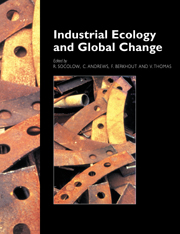Book contents
- Frontmatter
- Contents
- Foreword
- Preface
- Acknowledgments
- Contributors
- OVERVIEW
- PART 1 VULNERABILITY AND ADAPTATION
- PART 2 THE GRAND CYCLES: DISRUPTION AND REPAIR
- PART 3 TOXICS AND THE ENVIRONMENT
- 15 Introduction
- 16 Soil as a Vulnerable Environmental System
- 17 The Vulnerability of Biotic Diversity
- 18 Global Ecotoxicology: Management and Science
- 19 Industrial Activity and Metals Emissions
- 20 Metals Loading of the Environment: Cadmium in the Rhine Basin
- 21 Emissions and Exposure to Metals: Cadmium and Lead
- 22 Nuclear Power: An Industrial Ecology that Failed?
- PART 4 INDUSTRIAL ECOLOGY IN FIRMS
- PART 5 INDUSTRIAL ECOLOGY IN POLICY-MAKING
- END PIECE
- Organizing Committee Members
- Working Groups
- Index
17 - The Vulnerability of Biotic Diversity
Published online by Cambridge University Press: 04 August 2010
- Frontmatter
- Contents
- Foreword
- Preface
- Acknowledgments
- Contributors
- OVERVIEW
- PART 1 VULNERABILITY AND ADAPTATION
- PART 2 THE GRAND CYCLES: DISRUPTION AND REPAIR
- PART 3 TOXICS AND THE ENVIRONMENT
- 15 Introduction
- 16 Soil as a Vulnerable Environmental System
- 17 The Vulnerability of Biotic Diversity
- 18 Global Ecotoxicology: Management and Science
- 19 Industrial Activity and Metals Emissions
- 20 Metals Loading of the Environment: Cadmium in the Rhine Basin
- 21 Emissions and Exposure to Metals: Cadmium and Lead
- 22 Nuclear Power: An Industrial Ecology that Failed?
- PART 4 INDUSTRIAL ECOLOGY IN FIRMS
- PART 5 INDUSTRIAL ECOLOGY IN POLICY-MAKING
- END PIECE
- Organizing Committee Members
- Working Groups
- Index
Summary
Abstract
The presence or absence of a single species can cause a dramatic change in ecosystems, but our ability to predict which species can cause such change is limited. The disappearance of species can indicate changes in the ability of an ecosystem to sustain life over a long period of time. While there is an enormous literature on the losses of species associated with various industrial activities, the focus here is on changes in the earth's atmosphere that may cause biotic impoverishment. These include nitrogen deposition from fossil fuel combustion, increases in atmospheric carbon dioxide, and increased exposure to ultraviolet light due to a decrease in stratospheric ozone, all of which can be expected to result in changes in ecosystem function and species diversity.
Introduction
There are probably close to ten million species on earth. They are the products of long-term evolution in a variety of natural ecosystems, or biomes, that extend from the Arctic tundra to the tropics and from high mountains to the deepest sea. The presence of life on earth has profoundly affected the basic environmental conditions on the surface of this planet. Preservation of the biosphere is essential for the preservation of those conditions in which the human species has evolved and flourished on earth.
Humans must now assume a stewardship role for the biotic diversity of the planet. Barring a catastrophic geologic event, we have the power to determine our own success in this role. That is, will humans allow the resources of the planet to be fully usurped to support our own growing population and its material desires? Or will we allow a diversity of other living things to persist in nature?
- Type
- Chapter
- Information
- Industrial Ecology and Global Change , pp. 245 - 260Publisher: Cambridge University PressPrint publication year: 1994
- 8
- Cited by



